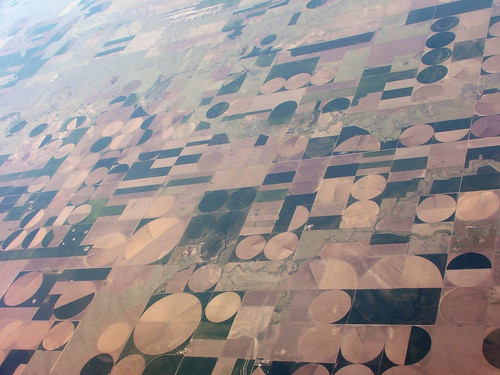1. What makes these shapes? Have you ever looked down from an airplane window and seen a sight like this? Something you will often see above large scale farming areas:
Give the students some time to digest these images - you will hear lots of wild theories.
 | |
|
Then show this picture and see if they can work it out:
 |
“Centre Pivot Irrigation” Matt Green
CC-BY-NC-SA
|
The Wikipedia page on Centre Pivot Irrigation has lots more interesting information.
2. Acting the Goat. Tie yourself with a rope to a chair or desk and pretend to be a goat. Explain how goats will eat absolutely everything in sight. Model the behaviour. A good laugh - and your class won't forget the locus of a circle or the concept of a constraint determining the locus. Then extend the idea to different situations of a goat on a leash (tied to a fence with a sliding leash, etc).
 |
| Built the idea of a locus by "acting the goat". |
3. Who cares about locus? Show an image like this:
 |
Astronaut Stephen K. Robinson, STS-114 mission specialist,
anchored to a foot restraint on the International Space Station’s Canadarm2.
Photo: NASA http://spaceflight.nasa.gov/gallery/images/shuttle/sts-114/html/s114e6647.html |
This person certainly cares about locus! Also a good opportunity to raise awareness of the International Space Station. More information on the Canadarm2 at http://science.nasa.gov/science-news/science-at-nasa/2001/ast18apr_1/
I said three ideas? Sorry - I can't resist sharing three more ...
4. "Locus Pocus" : A high quality video about locus well worth showing in class is Erica Morabito's Locus Pocus.
5. Introduce the ellipse : Most students have an idea what an ellipse is, but very few know how to make them or the locus idea behind them. This YouTube clip give a good demonstration:
and I wrap up this discussion with a picture of my favourite example of an ellipse in action:
 |
| Locus of the ellipse at work in the universe: a stunning NASA image of Io orbiting Jupiter. http://www.nasa.gov/mission_pages/juno/multimedia/pia02879.html |
6. Work the Geometry 'vs' Algebra dynamic: I find it helps students to be explicit about the two different approaches to curves (geometric versus algebraic). It seems to me many students prefer the algebraic - so we need to work extra hard to show the virtue and value of the locus view. I reintroduce our fellow travelers Euclid and Descartes and show the dynamic at work - that we want to be able to switch between them with ease.
Every time I have an idea or problem to develop with the class, I invoke the Euclid/Descartes duo. It's fun to have great mathematicians in the classroom with you - and it helps develop a broader of mathematics as a dynamic, developing intellectual inquiry - something students can participate in and perhaps even extend.
Every time I have an idea or problem to develop with the class, I invoke the Euclid/Descartes duo. It's fun to have great mathematicians in the classroom with you - and it helps develop a broader of mathematics as a dynamic, developing intellectual inquiry - something students can participate in and perhaps even extend.
Next post in this sequence: Teaching ideas for introducing the locus of the parabola.

Great ideas! I was hoping for more on "acting the goat" after you mentioned it before.
ReplyDeleteOne application for the locus idea of an ellipse: after learning it back in 4 unit in high school I next came across it doing a millinery course. Best way to draw a neat ellipse for a hat pattern!